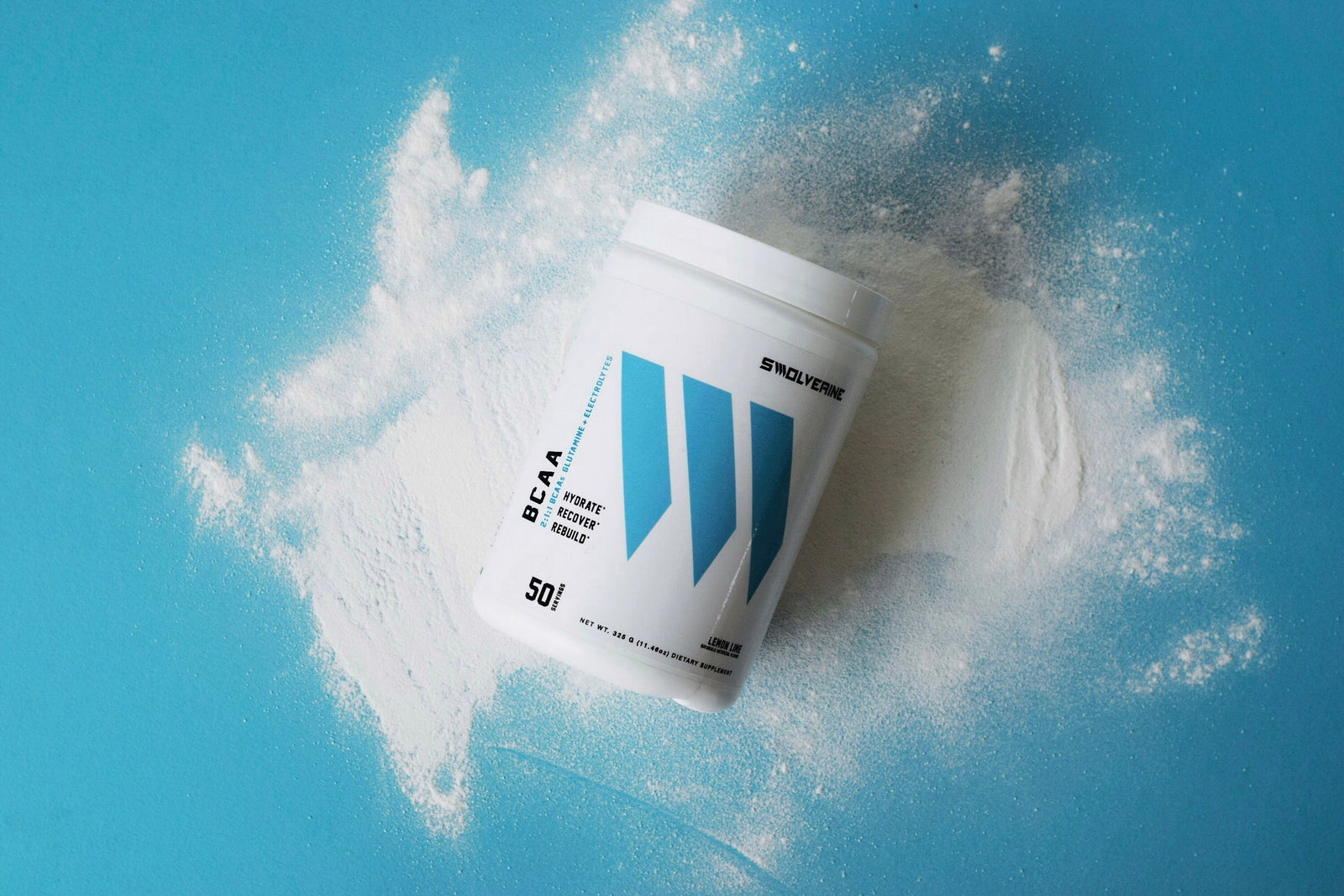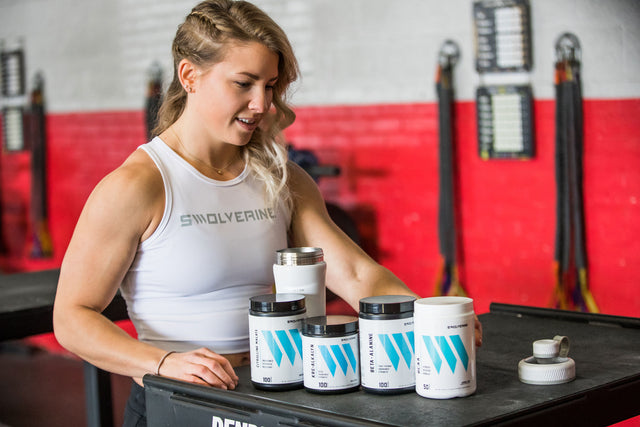Introduction: Small Aminos, Big Impact
You train hard. You recover smart. But if you’re skipping out on branched-chain amino acids (BCAAs), you might be leaving gains on the table.
BCAAs—leucine, isoleucine, and valine—aren’t just any amino acids. These three essentials play a powerful role in muscle growth, endurance, and recovery, especially when you’re pushing your body to the limit. Whether you’re lifting heavy, grinding through a WOD, or cutting calories to lean out, BCAAs can help you hold onto hard-earned muscle, fight fatigue, and bounce back faster.
In this guide, we’ll break down how BCAAs work, the ideal ratio to look for, and why these small but mighty aminos might be the secret weapon in your performance stack.
What Are Branched-Chain Amino Acids (BCAAs)?
BCAAs: The Building Blocks of Recovery and Performance
Branched-chain amino acids (BCAAs) are essential amino acids that play a critical role in muscle building, recovery, and performance. The term "branched-chain" refers to their chemical structure, and they consist of three key amino acids:
-
L-Leucine
-
L-Isoleucine
-
L-Valine
These amino acids are unique because they are metabolized in skeletal muscle rather than the liver, making them especially important during intense training and muscle repair.
How BCAAs Work: The Science Behind the Gains
Branched-chain amino acids (BCAAs)—leucine, isoleucine, and valine—are essential amino acids, meaning the body cannot produce them and they must be obtained through diet or supplementation.
What sets BCAAs apart is that unlike most amino acids, which are metabolized in the liver, BCAAs are primarily metabolized in skeletal muscle, allowing them to be used directly as an energy source during exercise. Leucine, in particular, serves as a key regulator of muscle protein synthesis (MPS) by activating the mTOR (mammalian target of rapamycin) signaling pathway, a critical driver of anabolic muscle growth. When leucine levels rise in the bloodstream, it signals the muscle cells to begin synthesizing new proteins—a process essential for muscle repair and hypertrophy. Meanwhile, isoleucine supports glucose uptake into muscle cells, providing fuel for training, and valine helps reduce central fatigue by competing with tryptophan for transport across the blood-brain barrier, lowering serotonin production and delaying the onset of perceived exertion.
Collectively, BCAAs support both anabolic signaling and muscular endurance, making them a powerful tool for athletes engaging in resistance training, endurance events, or calorie-restricted diets.
📚 Sources: Nair et al., 1992, Blomstrand et al., 2006, Wilson et al., 2011 – JISSN
Let me know if you'd like this turned into a graphic, callout box, or included in a training or product guide!
BCAA Ratios: What Do They Mean?
Most BCAA supplements are labeled with a ratio, which refers to the proportion of leucine:isoleucine:valine. For example:
Swolverine BCAA Formula:
-
2,000 mg L-Leucine
-
1,000 mg L-Isoleucine
-
1,000 mg L-Valine
➡️ 2:1:1 Ratio
The reason most BCAA products contain a higher dose of leucine is because leucine has the highest oxidation rate and is the most potent activator of muscle protein synthesis via the mTOR pathway.
📖 RELATED ARTICLE: Do BCAAs Really Work? And What Do BCAAs Do?
📚 Reference: Nair et al., 1992 – Am J Physiol
What Are the Benefits of BCAAs?
1. Improve Body Composition
In a randomized, double-blind, controlled study published in the Journal of the International Society of Sports Nutrition, 36 male athletes followed an 8-week resistance training program and were assigned to one of three groups:
-
14g BCAA/day
-
28g Whey Protein/day
-
28g Carbohydrate Sports Drink/day
Results:
-
Greater lean mass gains in the BCAA group
-
Increased strength
-
Greater body fat reduction than whey and carbs
📚 Reference: JISSN, 2009
💊 Recommended Product: Swolverine BCAA 2:1:1 with Glutamine + Coconut Water
2. Reduce Muscle Fatigue and Improve Endurance
During high-intensity workouts, fatigue is partly driven by increased serotonin (5-HT) levels in the brain. Here's how BCAAs help:
-
Tryptophan, the precursor to serotonin, competes with BCAAs to cross the blood-brain barrier
-
When BCAAs are present in higher concentrations, less tryptophan enters the brain
-
This leads to lower serotonin production, which can delay fatigue and increase endurance
📚 Reference: Blomstrand et al., 1997 – Acta Physiologica Scandinavica
✅ Supplementing BCAAs before or during your workout can reduce central fatigue and improve overall muscular endurance.
What’s the Best BCAA Ratio?
Why 2:1:1 Is Scientifically Superior
Many supplement companies market high-leucine formulas like 4:1:1 or 10:1:1, under the assumption that more leucine = more gains. But studies show that this is not necessarily the case.
A randomized, double-blind, placebo-controlled study at Baylor University tested leucine, BCAA (2:1:1), and placebo supplementation protocols across resistance-trained males.
Findings:
-
BCAAs triggered greater activation of the mTOR signaling pathway (via phosphorylated 4E-BP1)
-
The combination of leucine, isoleucine, and valine activated protein synthesis better than leucine alone
-
BCAAs improved anabolic signaling and muscle recovery more effectively than leucine-only formulations
📚 Reference: Wilson et al., 2011 – JISSN
✅ Conclusion: Stick with the 2:1:1 ratio—it delivers optimal results for muscle building, recovery, and endurance.
Conclusion: Fuel Recovery, Build Muscle, Stay Strong
In a world full of overhyped supplements, BCAAs stand out for one reason: they’re backed by science and built for results. From activating protein synthesis through the mTOR pathway to delaying fatigue and improving training endurance, BCAAs help you stay anabolic, even under stress.
Whether you're chasing bigger lifts, longer runs, or leaner gains, the right BCAA blend—especially one with a 2:1:1 ratio—can give you the edge you need to train harder, recover faster, and grow stronger.
Train smart. Recover right.
Add BCAAs to your protocol—and let your results speak for themselves.
Would you like this article adapted into a landing page or used as a supplement product breakdown for Swolverine’s BCAA formula? I can also create carousel posts or an email series based on this content!



